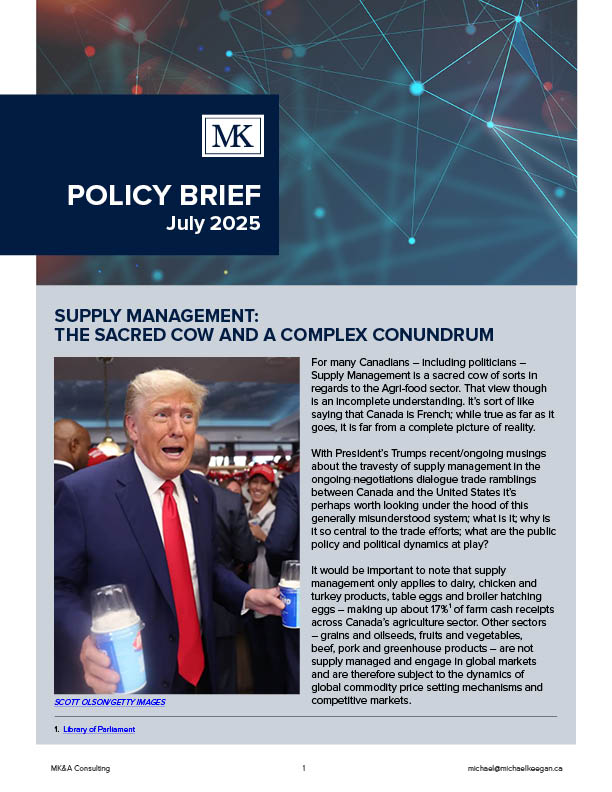SUPPLY MANAGEMENT: THE SACRED COW AND A COMPLEX CONUNDRUM
For many Canadians – including politicians – supply management is a sacred cow of sorts in regards to the Agri-food sector. That view however is an incomplete understanding. It’s sort of like saying that Canada is French; while somewhat true, it is far from a complete picture of reality.
With President’s Trumps recent/ongoing musings about the travesty of supply management in the ongoing negotiations dialogue trade ramblings between Canada and the United States, it’s perhaps worth looking under the hood of this generally misunderstood system; what is it; why is it so central to the trade efforts; what are the public policy and political dynamics at play?
It would be important to note that supply management only applies to dairy, chicken and turkey products, table eggs and broiler hatching eggs – making up about 17%¹ of farm cash receipts across Canada’s agriculture sector. Other sectors – grains and oilseeds, fruits and vegetables, beef, pork and greenhouse products – are not supply managed and engage in global markets that are subject to the dynamics of global commodity price setting mechanisms and competitive markets.
Supply managed farms are primarily concentrated in central Canada. This creates regional and agricultural sectoral tensions in both the public policy debate and around national trade negotiations – it is now especially acute with the current trade tensions with the U.S.
It’s also worth pointing out that agri-food in Canada is a big and dynamic business. Indeed, it is one of the foundational sectors of Canadian prosperity and domestic well-being. Taken as a whole (primary agriculture production and the food manufacturing sector) in 2024 it employed 2.3 million people, provided 1 in 9 jobs in Canada, and, generated $149.2 billion (around 7%) of Canada’s gross domestic product (GDP).
WHAT IS SUPPLY MANAGEMENT?
Supply Management began in the 1970’s as a response to challenges with the system aiming to balance the business interests/viability of farmers with upstream markets. The supply managed system is built on three core pillars²:
Production (supply) Control. This pillar regulates the quantity of agricultural products produced to try to balance supply and demand – this works dynamically with price setting (see below) to control supply and balance prices with costs. Through the purchase of production quotas, farmers produce a specified amount of product for sale to market.
Price Stability. Working through the provincial marketing boards, prices are set by measuring the costs of production and then requiring a market price for processors (and ultimately consumers) who must then pay for product.
Trade Protection. Supply management includes trade policies that limit imports – this is what Trump constantly refers to – creating a tariff wall that makes imports non-viable competitively. This effectively creates a domestic-only market for supply managed products and allows for the production and price controls outlined above.
In the complex world of international trade, the relationship between production control and trade protection lies at the heart of President Trump’s grievances. But as imports into Canada increase significantly, the ability to maintain domestic control over the market diminishes. Supporters of Canada’s supply management system point out that continued erosion of tariff barriers undermines the viability of the system and puts the existence of the system at risk.
It’s also important to highlight that sectors governed by supply management rarely export substantial quantities of their products. Thus, the primary concern for American farmers is not that they are facing unfair competition from Canadian producers; rather, they are seeking unhindered access to the Canadian market. This situation adds important layers of nuance to the ongoing discussions about trade between the two nations.
In summary, supply management is a system to isolate domestic production from international exports in dairy, eggs, broilers and turkey in order to regulate domestic prices and aggressively manage domestic market mechanisms.
PUBLIC POLICY DEBATE – BENEFITS AND CRITIQUE
Supporters argue that supply management yields predictable, fair prices for farmers while ensuring consumers receive high-quality staples. This system stands in stark contrast to the American agricultural landscape, characterised by greater volatility in pricing and more acute ethical concerns surrounding production practices. In many ways supply management is the most successful, targeted, taxpayer-friendly Buy Local system ever devised.
Conversely, critics highlight genuine concerns regarding consumer costs, asserting that the regulated system leads to higher prices than would otherwise prevail in a competitive environment. The rigidity of the system is seen to stifle innovation and productivity, while restrictive trade practices prevent Canada from engaging effectively with potentially lucrative global markets.
Critics also point to high capital requirements for entry (not least of which is the need to acquire expensive quota for production). This means limited opportunity for new entrants, with existing producers controlling the systems – critics would suggest, much like a cartel. If a new processor – for example – wanted to set up shop in Canada they would first need to secure access to product supply under the quota system. A difficult task in that the existing producers and processors control access to the production quota (a clear conflict when those new entrants are your future competitors).
The issue of food waste, exemplified by the dumping of milk, also reflects poorly on the industry, but does remain a necessary evil to maintain supply equilibrium.
Overall, support for supply management is not universal, with significant concerns about its effectiveness and fairness — especially given Canada’s economic reliance on access to international markets. Recognizing that the system operates under a complicated regulatory framework established by both federal and provincial governments, any movement towards its discontinuation or revision presents a significant public policy challenge.
WHY DOES SUPPLY MANAGEMENT SEEM TO BE SO CENTRAL TO CANADA’S TRADE INTERESTS?
Most countries have sensitive products/industries that are protected within trade negotiations. India for example is refusing to budge on agriculture tariffs – including Dairy – that they claim are required to protect small and rural farmers from large and subsidized American producers. Similarly, Japan has long protected sensitive products with tariffs on key agricultural products like rice, wheat, beef, pork, dairy, and sugar aimed at protecting domestic producers.
In all countries, these sensitive products/industries are often driven by domestic political considerations – it is worth remembering that the Arab spring³, for example, was catalyzed by the rising cost of bread —a stark reminder of the political potency of food security.
Supply management is indeed important to some – and there are some key ridings in Quebec for which supply management might be a consequential electoral issue. However, notwithstanding some of the recent explanations for supply management’s enduring political viability, it is over-simplistic to suggest that a few ridings in Quebec is the reason for the systems endurance. Like most public policy challenges the full explanation is more complex. Part of the more comprehensive explanation is that any radical reform or wind-down of this system could be costly. The federal and provincial governments would likely need to “buy back” quotas from current farmers, a negotiation fraught with political peril. To date, the benefits of maintaining supply management have outweighed the potential costs of reform, as ministers grapple with the complexities and ramifications of altering such a deeply entrenched system.
If, however, a full-scale reform of the system does come to pass, the most likely path forward would look something like the managed transition proposed several years ago in a report by the Canada West Foundation, authored by Martha Hall-Findley.
Additionally, despite common perception, governing is hard. Within government cabinet Ministers have to manage their portfolios, stakeholder and especially their budgets. Finance has considerable influence and control of Ministries and Departments as they hold the purse strings. In Agriculture and Agri-food there are always budget pressures from primary production as governments respond to a host of weather, market and other crisis that are endemic to the sector. As a result, Finance likes supply management because it knows the sector never really needs or demands extraordinary support payments.
Public ignorance surrounding agricultural issues only exacerbates the situation, as many Canadians conflate support for farmers with support for supply management, overlooking the critical trade-offs involved. Non-supply-managed sectors, now facing the implications of Bill C-202, are understandably concerned; this legislation complicates trade negotiations and makes concessions detrimental to supply-managed sectors significantly harder to achieve. The worry is not merely about protecting these sectors, but rather ensuring that the 83% of agriculture regulated outside supply management does not lose essential access to international markets.
NEGOTIATING STRATEGY
Some observers argue that supply management may offer strategic advantages at the trade negotiation table. Unlike the stroke-of-pen changes seen with the Digital Services Tax (DST) rollback in July, modifying supply management is a lengthy and intricate process, demanding substantial effort and time. It cannot simply be “undone”.
Thus, any trade discussions involving supply management must weigh the costs and advantages of maintaining, modifying, or reforming the system against Canada’s overall economic, social, and political interests.
If the past is any predictor of the future, than the most likely outcome from the current trade tensions for supply management should look like what we saw from CETA⁴ – i.e. increased market access (Tariff Rate Quotas) – but of course who knows if that will satisfy the Trump. Trump is listening to his own farmers – especially the U.S. Dairy sector – that is clamouring for significantly greater access to Canada’s protected supply managed sectors.
The future of Canadian supply management will hinge not only on political will, but also on the public’s evolving understanding of agricultural policies. As attention to agricultural issues heightens—particularly in the context of escalating U.S. trade tensions—stakeholders will require a robust public policy narrative to justify the system’s continuation.
Indeed, tough decisions lie ahead as the nation navigates the intricate interplay of domestic needs and international pressures, underscoring the necessity for informed, serious public discussion in this era of heightened scrutiny.
IN MEMORY OF PETER HANNAM
Peter Hannam recently passed away. He was a celebrated leader in the agriculture sector. I knew of Peter long before I ever met him and when I did meet him and got to know him over the years, it was clear that his reputation was well deserved. More recently, I would see Peter regularly at the YMCA in Guelph. We would talk about family, about politics, about agriculture and of course share a few jokes and barbs. I already miss those little interactions. We extend our sincere condolences to his family of which he was immensely proud. Rest in peace, Peter.
3. Use your loaf: why food prices were crucial in the Arab spring
4. CETA (Comprehensive Economic and Trade Agreement) does not impact Canada’s supply management system, which remains robust.The agreement maintains the three pillars of supply management: production control, import controls, and price controls. CETA does, however, increase market access for some agricultural products, including a specific quota for EU cheese into Canada. This increase in market access has led to concerns about potential negative impacts on Canadian dairy farmers and the broader industry, particularly with the reduction of domestic milk production.

